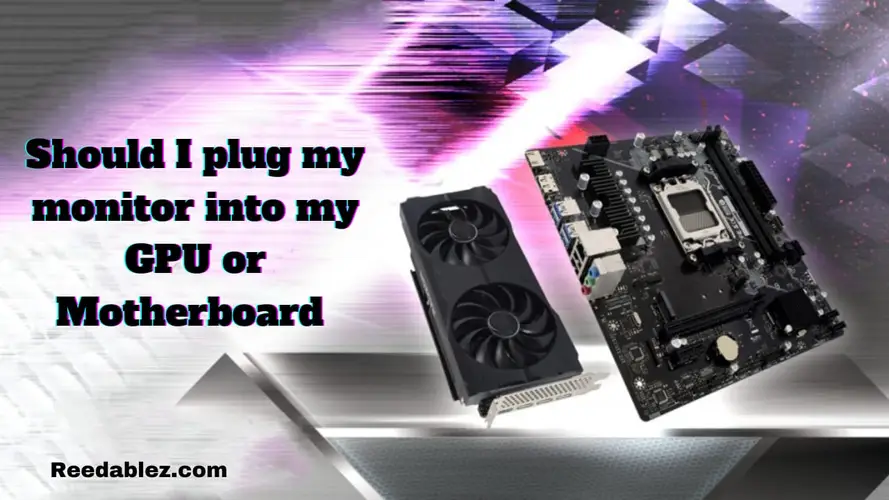How to use all cores on CPU?
April 14, 2018

When setting up or upgrading a PC, one common question is whether to plug the monitor into the Graphics Processing Unit (GPU) or the motherboard's video output. Both options are viable but have distinct implications for performance and functionality.
Consider your computing needs when deciding whether to plug your monitor into your GPU or motherboard. For gaming, graphics-intensive tasks, and multitasking, connect to the GPU for optimized performance.
This comprehensive guide will explore each choice's considerations, advantages, and scenarios, helping you decide based on your specific needs.
A dedicated GPU is a separate graphics card that provides superior graphical performance. It's designed to handle demanding gaming, video editing, and 3D rendering tasks. Modern GPUs offer high resolutions, multiple display outputs, and support for advanced graphics technologies.
Most motherboards have integrated or onboard graphics solutions. These are essential graphics processors integrated directly into the motherboard, typically used for everyday tasks like web browsing, office applications, and video playback. They may have limited gaming capabilities and support lower resolutions.
GPU: Plugging your monitor into a GPU results in significantly better graphics performance. It's ideal for gaming, 3D rendering, and tasks that demand high visual quality.
Motherboard Graphics: Using motherboard graphics suits basic tasks but may struggle with resource-intensive applications or games.
GPU: Most GPUs offer multiple video outputs, allowing you to connect multiple displays. This is essential for multitasking and gaming across various screens.
Motherboard Graphics: Onboard graphics typically support only one display, limiting multitasking capabilities.
GPU: GPUs support higher resolutions (e.g., 4K) and higher refresh rates (e.g., 144Hz and beyond), providing smoother gameplay and enhanced visual experiences.
Motherboard Graphics: Onboard graphics may limit resolution and refresh rates, affecting visual quality and gaming performance.
GPU: If you engage in graphics-intensive tasks like video editing, 3D modeling, or scientific simulations, a GPU is essential for accelerated performance.
Motherboard Graphics: Onboard graphics may struggle with such tasks, leading to slower rendering and less efficient workflows.
Recommendation: Connect your monitor to the GPU. This ensures optimal gaming performance, high resolutions, and smooth gameplay. The GPU's dedicated processing power is essential for these scenarios.
Recommendation: Plugging your monitor into the motherboard's video output suits everyday tasks like web browsing, office applications, and video playback. It conserves power and extends the GPU's lifespan.
Recommendation: Use the GPU if you have multiple monitors. GPUs offer more display outputs, which is necessary for driving various displays efficiently.
Recommendation: In some cases, the choice may be dictated by compatibility. Some systems require specific configurations to activate the GPU's video outputs. Check your motherboard and GPU documentation for compatibility information.
Recommendation: In a hybrid configuration, where you need graphics power and multiple displays, you can use the GPU and motherboard video outputs. However, this requires advanced configuration and driver settings.

Enter your computer's BIOS/UEFI settings to switch between motherboard and GPU graphics. Here, you can select the primary display device. Consult your motherboard's manual for specific instructions.
Ensure you have the necessary graphics drivers installed. GPUs typically require dedicated graphics drivers, while onboard graphics rely on motherboard drivers. Keep these drivers up to date for optimal performance.
Some systems support dual graphics configurations, where the GPU and onboard graphics work together. This can be advantageous for specific use cases but requires compatibility and additional setup.
If you encounter a "no display" issue, ensure your monitor is connected to the correct video output, whether the GPU or motherboard. Verify that all necessary drivers are installed.
In some cases, driver conflicts can occur using GPU and onboard graphics. Troubleshoot by updating or reinstalling the graphics drivers. It would be best if you also read how to free up GPU memory in your computer.
The decision to plug your monitor into the GPU (Graphics Processing Unit) or motherboard involves several factors that can significantly impact your computing experience. To make an informed choice, consider the following factors:
One of the most critical factors to consider is your computer's intended use. Your choice should align with the primary tasks you'll be performing.
If you plan to use your computer for gaming, video editing, 3D rendering, or any other graphics-intensive tasks, connecting your monitor to the GPU is highly recommended. Dedicated GPUs are designed to handle such tasks efficiently. They offer superior graphical performance, high resolutions, and support for advanced graphics technologies. Connecting to the GPU ensures you get the most out of these applications.
Plugging your monitor into the motherboard's video output is sufficient for basic everyday tasks like web browsing, email, word processing, and office applications. Motherboard graphics (integrated or onboard) can handle these tasks comfortably while conserving power. Using the GPU for such studies may be overkill and lead to unnecessary power consumption.
If power efficiency is a concern, connecting your monitor to the motherboard is a practical choice. Motherboard graphics tend to be more power-efficient than dedicated GPUs. This is particularly important when minimizing electricity usage, such as in office environments or when running on laptop battery power.
Consider your multitasking needs. Connecting your monitor to the GPU is essential if you require multiple displays for productivity, design work, or multitasking. Dedicated GPUs typically offer numerous video outputs, enabling you to efficiently run multiple displays simultaneously. This is crucial for scenarios where you must monitor several applications, spreadsheets, or documents simultaneously.
Your monitor's resolution and refresh rate requirements significantly influence your decision. Connecting it to the GPU is vital if you have a high-resolution monitor (e.g., 4K) or a high-refresh-rate monitor (e.g., 144Hz or more).
GPUs can handle these demanding resolutions and refresh rates, providing smoother gameplay and enhanced visual experiences. Onboard graphics may have limitations, affecting visual quality and gaming performance.
The GPU is the obvious choice if you prioritize graphics quality and performance. GPUs have dedicated processing power, powerful graphics cores, and advanced features that enhance visual fidelity and deliver smoother game frame rates.Onboard graphics, while suitable for basic tasks, do not match the performance and quality of dedicated GPUs.
Compatibility between your motherboard and GPU can affect your choice. Some systems may require specific configurations to activate the GPU's video outputs. Ensure that your GPU and motherboard are compatible, and consult their respective manuals for information on video output configurations.
Specialized use cases may require unique considerations. For example, connecting to motherboard graphics is sufficient if you're running a server without a dedicated display.
In a hybrid configuration, where you need graphics power and multiple displays, you can use both the GPU and motherboard video outputs, but this requires advanced configuration and driver settings.
The choice may also involve driver and software support. Dedicated GPUs require their specific graphics drivers, while motherboard graphics rely on motherboard drivers. Keep these drivers up to date to ensure optimal performance.
Connecting the monitor to the GPU may be preferred for users who want a clean and tidy setup without additional cables. Many GPUs have ample video outputs for multiple monitors, allowing for a neat and organized setup.
Whether to plug your monitor into the GPU or motherboard hinges on your specific use cases and requirements. Both options have their advantages and limitations.
By carefully considering these factors and aligning your choice with your computing needs, you can optimize your computer's performance and functionality to suit your goals and preferences. Ultimately, the decision is flexible and should cater to your unique requirements.
Choosing between the GPU (Graphics Processing Unit) and motherboard for connecting your monitor is a crucial decision that impacts your computer's performance, functionality, and overall user experience. Here are the key reasons why this choice is significant:
One of the primary reasons for making this choice is performance optimization. The GPU is specifically designed for rendering graphics and handling graphics-intensive tasks. It boasts dedicated processing power, high-performance graphics cores, and advanced features that significantly outperform onboard graphics solutions found in motherboards.
Connecting your monitor to the GPU ensures you harness this power for demanding tasks like gaming, video editing, 3D rendering, and scientific simulations. It translates to smoother gameplay, faster rendering, and enhanced graphics quality.
The choice between the GPU and motherboard also directly impacts your computer's display's resolution and visual quality. Dedicated GPUs support higher resolutions, including 4K and beyond, and can handle high refresh rates for smoother visuals.
This is particularly important for gaming and tasks where visual clarity and quality are paramount. Onboard graphics, however, may have limitations that can affect the overall visual experience.
Connecting your monitor to the GPU is essential for users who rely on multiple displays for multitasking, productivity, or creative work. Most GPUs offer numerous video outputs, enabling you to efficiently run multiple displays simultaneously.
This is invaluable for monitoring applications, spreadsheets, documents, or creative projects. Onboard graphics typically support only one show, limiting your multitasking capabilities.
Specific tasks like video editing, 3D modeling, scientific simulations, and professional content creation demand robust graphics processing. These tasks benefit significantly from the computational power of dedicated GPUs.
Plugging your monitor into the GPU ensures it can handle these graphics-intensive workloads efficiently, resulting in quicker rendering and more streamlined workflows.
Gaming enthusiasts will find that their choice of GPU or motherboard graphics directly impacts their gaming experience. Modern games are graphically demanding and benefit from the dedicated processing power and advanced features provided by GPUs.
Plugging your monitor into the GPU allows for high frame rates and smooth gameplay and supports features like ray tracing and advanced graphics effects.
Compatibility is another crucial aspect to consider. Some systems may require specific configurations to activate the GPU's video outputs. Ensuring compatibility between your motherboard and GPU is essential to make the correct choice.
In particular, use cases, like running a server without a dedicated display and connecting to motherboard graphics, may be sufficient. Such unique considerations can also guide your decision.
Power consumption is a factor to weigh in your decision. Onboard graphics are generally more power-efficient than dedicated GPUs. If you're concerned about energy consumption, particularly in office environments or for laptops running on battery power, connecting your monitor to the motherboard can help conserve power.
Whether to plug your monitor into your GPU or motherboard depends on your specific needs and use cases. Connecting your monitor to the GPU is the clear choice for gaming, graphics-intensive tasks, and high-performance requirements. The motherboard's video output is sufficient for everyday tasks and power conservation. Ultimately, the option is yours, and you can adapt it to your unique computing demands. Consider the factors mentioned in this guide to make the best decision for your setup.
You can typically switch between GPU and motherboard graphics output in your computer's BIOS/UEFI settings. However, the ease of switching can depend on your motherboard and GPU compatibility.
It is recommended to connect your monitor to the GPU for gaming and graphics-intensive tasks. Dedicated GPUs offer superior performance and support for high resolutions and refresh rates.
Connecting your monitor to the motherboard is generally not preferred for gaming. Motherboard graphics are less capable and may result in suboptimal gaming experiences.
If you need to use multiple monitors, it is advisable to connect them to the GPU. Dedicated GPUs typically offer more video outputs, allowing you to drive various displays efficiently.
Some systems support dual graphics configurations, where the GPU and onboard graphics work together. However, this requires advanced design and compatibility.
Connecting the monitor to the motherboard may benefit power conservation and basic tasks like web browsing and office applications. It is also helpful in scenarios where graphics performance is not a primary concern.
Comments
Write a comment